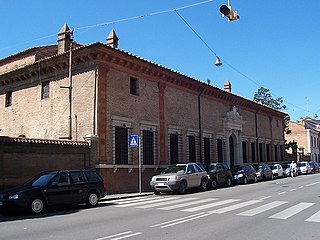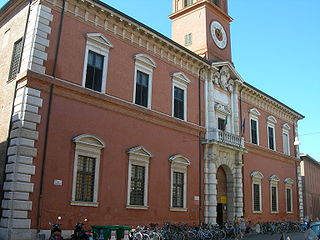
The Galleria Nazionale d'Arte Antica (GNAA), or National Gallery of Ancient Art, is an art gallery in Rome, Italy, the main national collection of older paintings in Rome. It has two sites: the Palazzo Barberini and the Palazzo Corsini.

Palazzo dei Diamanti is a Renaissance palace located on Corso Ercole I d'Este 21 in Ferrara, region of Emilia Romagna, Italy. The main floor of the Palace houses the Pinacoteca Nazionale di Ferrara.

The Palazzo Corsini is a prominent late-baroque palace in Rome, erected for the Corsini family between 1730–1740 as an elaboration of the prior building on the site, a 15th-century villa of the Riario family, based on designs of Ferdinando Fuga. It is located in the Trastevere section of the city, and stands beside the Villa Farnesina. During 1659–1689, the former Riario palace had hosted the eccentric Christina, Queen of Sweden, who abdicated, converted, and moved to Rome. Under her patronage, this was the site for the first meetings of the Roman Accademia dell'Arcadia.

Museo di Storia Naturale di Venezia is a museum of natural history housed in Fondaco dei Turchi, located on the Grand Canal, Venice, Italy. Its collections relate mainly to the natural history of the Venetian lagoon that surrounds the city. Today it is one of the 11 venues managed by the Fondazione Musei Civici di Venezia.

The Biblioteca Estense, was the family library of the dukes of Este. Dating to at least the 14th century, it was largely enriched during Ferrara's Renaissance, and finally established in Modena in the beginning of the 17th century. It is one of the most important libraries in Italy. The library is located, along with the Galleria Estense with its collection of artworks, in the Palazzo del Musei, Largo Sant'Agostino 337
The Biblioteca Comunale Ariostea is located in the Palazzo Paradiso in central Ferrara, region of Emilia-Romagna, Italy. It was named Ariostea, because the collection contains manuscripts related to the author, and within the palace also lies the tomb of Ludovico Ariosto.

The Palazzo Bentivoglio is a late-Renaissance palace located on Via Garibaldi in central Ferrara, Region of Emilia-Romagna, Italy

The Palazzina Marfisa d’Este is a Renaissance-style small palace, once suburban, and sometimes referred to as a villa, located on Corso Giovecca #170, just east of Central Ferrara, region of Emilia-Romagna, Italy.
The Palazzo Massari, also known as the Palazzo Rosso, is a Renaissance-style palace located on Borso and Corso Porta Mare, at the northwest corner of Piazza Ariostea, in Ferrara, region of Emilia-Romagna, Italy.

The Museo di Roma is a museum in Rome, Italy, part of the network of Roman civic museums. The museum was founded in the Fascist era with the aim of documenting the local history and traditions of the "old Rome" that was rapidly disappearing, but following many donations and acquisitions of works of art is now principally an art museum. The collections initially included 120 water-colours by the nineteenth-century painter Ettore Roesler Franz of Roma sparita, "vanished Rome", later moved to the Museo di Roma in Trastevere.

The Palazzo Paradiso is a Renaissance palace located on Via Scienze #17 in the medieval center of Ferrara, region of Emilia-Romagna, Italy. Adjacent to the historic Jewish ghetto of Ferrara, it houses:

Marfisa d'Este was a Ferrarese noblewoman. She was the illegitimate daughter of Francesco d'Este - her mother's name is unknown. She and her sister Bradamante were legitimised by both pope Gregory XIII and Alfonso II d'Este. She was also notable as a patron of the arts and the protector of Torquato Tasso.
The Palazzo Lanfranchi is a palace located on Lungarno Galileo Galilei #8, in the city of Pisa, region of Tuscany, Italy.
Giovanni Maria Riminaldi was an Italian Roman Catholic cardinal.
Raimondo Ghelli was an Italian engraver and painter of the 18th-century, active in making portraits.
The following is a timeline of the history of the city of Ferrara in the Emilia-Romagna region of Italy.















